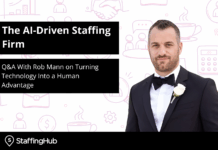
Key takeaways:
- Boomerang hiring has surged dramatically, reaching 35% of all new hires in March 2025, with the information sector seeing the most growth.
- The trend is driven by skills scarcity, faster onboarding needs, economic uncertainty, and employees revisiting their previous jobs after the pandemic-era job switching frenzy.
- Staffing agencies can capitalize by building alumni networks, offering reunion services to employers, and maintaining long-term candidate relationships.
According to new data from ADP, boomerang hiring — the practice of rehiring former employees — has surged to unprecedented levels, reaching 35% of all new hires in March 2025, up from 31% just a year earlier.
While boomerang employees have represented only 2% of all active employees since 2018, they account for more than one-third of new hires. This is a sustained trend that has been building momentum since the post-pandemic recovery.
The trend is particularly noticeable in the information sector — nearly two-thirds (68%) of new information hires in March 2025 were returning employees, representing a two-fold increase from the previous year. Over the past 12 months, boomerang hires in the information sector have averaged 45%, compared to just 30% since 2018.
This surge contrasts sharply with the “Great Resignation” period of 2022, when voluntary quits hit record highs and boomerang hiring dropped to a low of 26%. Now, with quits falling by more than 25% from their March 2022 peak, the pendulum has swung decisively toward rehiring familiar talent.
What’s driving boomerang hiring?
Several factors are converging to make boomerang hiring attractive to employers:
- Skills scarcity and geographic concentration: In specialized fields like technology, workers with the right skill sets can be difficult to find. When certain expertise is geographically concentrated, bringing back former employees becomes an efficient way to secure needed capabilities.
- Faster onboarding and immediate impact: Former employees require less training and can hit the ground running. In an environment where employers are focused on efficiency gains amid economic uncertainty, this advantage becomes particularly valuable.
- The reality check factor: Many employees who left during the pandemic-era job switching frenzy have discovered that the grass isn’t always greener. With lower residential mobility rates limiting workers’ options, returning to familiar employers has become more appealing.
- Economic uncertainty: Both employers and employees are gravitating toward familiar relationships when facing uncertain economic conditions. This mutual caution is driving more conservative hiring and job-switching decisions.
How does this trend impact staffing firms?
The boomerang hiring trend validates what the staffing agencies have always known: recruiting is fundamentally about relationships, not transactions. Agencies that have maintained strong candidate connections may find these relationships represent untapped revenue potential:
1. Develop an alumni network
Systematically track and maintain relationships with placed candidates throughout their career journeys. This means building robust alumni databases that capture not just initial placements, but career progression, skill development, and changing preferences over time.
Action steps:
- Take advantage of software systems designed to track long-term candidate relationships
- Create regular touchpoint schedules for maintaining contact with placed candidates
- Develop alumni newsletters and networking events to keep your agency top-of-mind
2. Explore employer reunion services
Position your agency as a specialist in facilitating employer-employee reunions. Many companies lack the infrastructure to effectively track and reconnect with former employees, creating a service gap that staffing agencies can fill.
Service offerings:
- Former employee tracking and outreach services
- Alumni database management for client companies
- Specialized reunion events and networking opportunities
3. Focus boomerang initiatives on specific industries
Given the dramatic surge in information sector boomerang hiring, agencies should consider developing specialized practices around high-turnover, skill-intensive industries where boomerang hiring offers the greatest value.
Target sectors:
- Information technology and software development
- Healthcare and specialized medical roles
- Professional services with geographic skill concentrations
- Finance and insurance, where relationships and institutional knowledge matter
4. Enhance candidate intelligence
Invest in systems and processes that capture deeper insights about why candidates leave positions and what might bring them back. This intelligence becomes invaluable when approaching former placements about boomerang opportunities.
Intelligence gathering:
- Exit interview data collection and analysis
- Career satisfaction surveys for placed candidates
- Market compensation and benefits benchmarking
- Workplace culture and environment assessments
In today’s cautious job market, how candidates leave positions matters more than ever because they’re increasingly likely to return. Staffing agencies that excel at maintaining long-term candidate relationships and facilitating successful reunions will capture a growing share of this expanding market segment.
The key to success lies in thinking beyond individual placements to building lasting professional relationships that benefit all parties involved. In the boomerang economy, your next great placement might be someone you’ve already successfully placed before.





